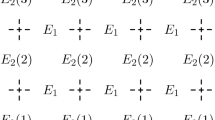Abstract
A random phase property establishing in the weak coupling limit a link between quasi-one-dimensional random Schrödinger operators and full random matrix theory is advocated. Briefly summarized it states that the random transfer matrices placed into a normal system of coordinates act on the isotropic frames and lead to a Markov process with a unique invariant measure which is of geometric nature. On the elliptic part of the transfer matrices, this measure is invariant under the unitaries in the hermitian symplectic group of the universality class under study. While the random phase property can up to now only be proved in special models or in a restricted sense, we provide strong numerical evidence that it holds in the Anderson model of localization. A main outcome of the random phase property is a perturbative calculation of the Lyapunov exponents which shows that the Lyapunov spectrum is equidistant and that the localization lengths for large systems in the unitary, orthogonal and symplectic ensemble differ by a factor 2 each. In an Anderson-Ando model on a tubular geometry with magnetic field and spin-orbit coupling, the normal system of coordinates is calculated and this is used to derive explicit energy dependent formulas for the Lyapunov spectrum.
Similar content being viewed by others
References
Anderson, P.W.: Absence of diffusion in certain random lattices. Phys. Rev. 109, 1492–1505 (1958)
Anderson, P.W., Thouless, D.J., Abrahams, E., Fisher, D.S.: New method for a scaling theory of localization. Phys. Rev. B 22, 3519–3526 (1980)
Ando, T.: Numerical study of symmetry effects on localization in two dimensions. Phys. Rev. B 40, 5325–5339 (1989)
Beenakker, C.W.J.: Random-matrix theory of quantum transport. Rev. Mod. Phys. 69, 731–808 (1997)
Beenakker, C.W.J., Büttiker, M.: Suppression of shot noise in metallic diffusive conductors. Phys. Rev. Lett. 46, 1889–1892 (1992)
Bougerol, P., Lacroix, J.: Products of Random Matrices with Applications to Schrödinger Operators. Birkhäuser, Boston (1985)
Chalker, J.T., Bernhardt, M.: Scattering theory, transfer matrices, and Anderson localization. Phys. Rev. Lett. 70, 982–985 (1993)
Dorokhov, O.N.: Electron localization in a multichannel conductor. Sov. Phys. JETP 58, 606–615 (1983)
Dorokhov, O.N.: On the coexistence of localized and extended electronic states in the metalic phase. Solid State Commun. 51, 381–384 (1984)
Dorokhov, O.N.: Solvable model of multichannel localization. Phys. Rev. B 37, 10526–10541 (1988)
Dyson, F.: The dynamics of a disordered linear chain. Phys. Rev. 92, 1331–1338 (1953)
Efetov, K.B., Larkin, A.I.: Kinetics of a quantum particle in long metallic wires. Sov. Phys. JETP 58, 444–451 (1983)
Froufe-Pérez, L.S., Yépez, M., Mello, P.A., Sáenz, J.: Statistical scattering of waves in disordered waveguides: From microscopic potentials to limiting macroscopic statistics. Phys. Rev. E 75, 031113–031141 (2007)
Hiai, F., Petz, D.: The Semicircle Law, Free Random Variables and Entropy. AMS, Providence (2000)
Howard, J.E., MacKay, R.S.: Linear stability of symplectic maps. J. Math. Phys. 28, 1036–1051 (1987)
Kramer, B., Schreiber, M.: Transfer-matrix methods and finite-size scaling for disordered systems. In: Hoffmann, K.H., Schreiber, M. (eds.) Computational Physics, pp. 166–188. Springer, Berlin (1996)
Macêdo, A.M.S., Chalker, J.T.: Effects of spin-orbit interactions in disordered conductors: A random-matrix approach. Phys. Rev. B 46, 14985–14994 (1992)
MacKinnon, A., Kramer, B.: One-parameter scaling of localization length and conductance in disordered systems. Phys. Rev. Lett. 47, 1546–1549 (1981)
Mehta, M.L.: Random Matrices, 2nd edn. Academic Press, San Diego (1991)
Mello, P.A., Pereyra, P., Kumar, N.: Macroscopic approach to multichannel disordered conductors. Ann. Phys. 181, 290–317 (1988)
Mello, P.A., Shapiro, B.: Existence of a limiting distribution for disordered electronic conductors. Phys. Rev. B 37, 5860–5863 (1988)
Mello, P.A., Stone, A.D.: Maximum-entropy model for quantum-mechanical interference effects in metallic conductors. Phys. Rev. B 44, 3559–3576 (1991)
Mello, P.A., Tomsovic, S.: Scattering approach to quantum electronic transport. Phys. Rev. B 46, 15963–15981 (1992)
Pastur, L., Figotin, A.: Spectra of Random and Almost-Periodic Operators. Springer, Berlin (1992)
Pichard, J.-L., Sarma, G.: Finite-size scaling approach to Anderson localisation I. J. Phys. C 14, L127–132 (1981)
Pichard, J.-L., Sarma, G.: Finite-size scaling approach to Anderson localisation II. J. Phys. C 14, L617–625 (1981)
Römer, R.A., Schreiber, M.: Numerical investigations of scaling at the Anderson transition. In: Brandes, T., Kettemann, S. (eds.) The Anderson Transition and its Ramifications—Localisation, Quantum Interference, and Interactions. Lecture Notes in Physics, vol. 630, pp. 3–19. Springer, Berlin (2003)
Römer, R.A., Schulz-Baldes, H.: Weak disorder expansion for localization lengths of quasi-1D systems. Eur. Phys. Lett. 68, 247–250 (2004)
Sadel, C., Schulz-Baldes, H.: Scaling diagram for the localization length at a band edge. Ann. Henri Poincaré 8, 1595–1621 (2007)
Sadel, C., Schulz-Baldes, H.: Random Dirac operators with time reversal symmetry. Commun. Math. Phys. 295, 209–242 (2010)
Sadel, Ch., Schulz-Baldes, H.: Random Lie group actions on compact manifolds: a perturbative analysis. Ann. Probab. (2008, to appear)
Schmidt, H.: Disordered one-dimensional crystals. Phys. Rev. 105, 425–441 (1957)
Schulz-Baldes, H.: Perturbation theory for an Anderson model on a strip. Geom. Funct. Anal. 14, 1089–1117 (2004)
Schulz-Baldes, H.: Rotation numbers for Jacobi matrices with matrix entries. Math. Phys. Electron. J. 13 (2007). 40 pages
Thouless, D.J.: Maximum metallic resistance in thin wires. Phys. Rev. Lett. 39, 1167–1170 (1977)
Author information
Authors and Affiliations
Corresponding author
Rights and permissions
About this article
Cite this article
Römer, R.A., Schulz-Baldes, H. The Random Phase Property and the Lyapunov Spectrum for Disordered Multi-channel Systems. J Stat Phys 140, 122–153 (2010). https://doi.org/10.1007/s10955-010-9986-8
Received:
Accepted:
Published:
Issue Date:
DOI: https://doi.org/10.1007/s10955-010-9986-8




